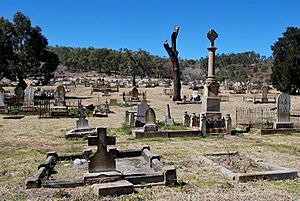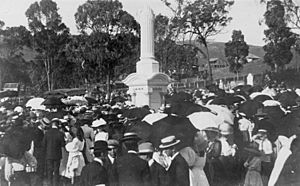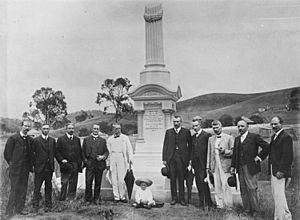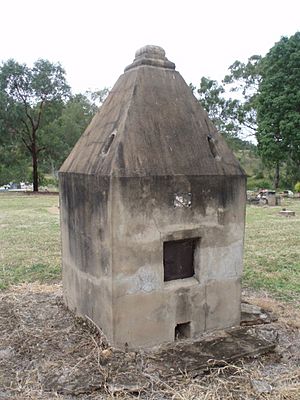Mount Morgan Cemetery facts for kids
Quick facts for kids Mount Morgan Cemetery |
|
|---|---|

Mount Morgan Cemetery, 2008
|
|
| Location | East Street, Mount Morgan, Rockhampton Region, Queensland, Australia |
| Design period | 1870s - 1890s (late 19th century) |
| Built | 1886 |
| Owner | Rockhampton Regional Council |
| Official name: Mount Morgan Cemetery including Chinese Shrine and Linda Memorial | |
| Type | state heritage (landscape, built) |
| Designated | 21 October 1992 |
| Reference no. | 600753 |
| Significant period | 1886- (social) 1886-1990s (historical, fabric) |
| Significant components | grave marker, headstone, gate - entrance, memorial - cairn, seating, chinese ceremonial burner, memorial - column (broken), pathway/walkway, trees - remnant scrub, sarcophagus |
| Lua error in Module:Location_map at line 420: attempt to index field 'wikibase' (a nil value). | |
The Mount Morgan Cemetery is a special heritage-listed cemetery located on East Street in Mount Morgan, Australia. It was first opened in 1886. This cemetery is important because it tells us a lot about the history of the town. It was added to the Queensland Heritage Register on October 21, 1992, which means it's protected for its historical value.
Contents
A Look Back: History of the Cemetery
The very first person buried in the Mount Morgan Cemetery was James Kennedy in 1886. The land for the cemetery was officially set aside in 1889. It covers about 4.5 hectares (that's about 11 acres) of land south of the town. People still use it today, and it has many beautiful and unique memorials.
Mount Morgan: A Mining Town's Story
Mount Morgan grew because of the huge Mount Morgan Mine. This mine was located on the Dee River, about 30 kilometers (19 miles) southwest of Rockhampton. Gold was first found in the area in 1870. However, it wasn't until 1882 that the three Morgan brothers and other business people formed a group to mine the rich deposits.
The Mount Morgan Mine operated for 99 years. It produced an amazing 225,000 kilograms (almost 500,000 pounds) of gold. It also yielded 50,000 kilograms (110,000 pounds) of silver and 360,000 metric tons (almost 800 million pounds) of copper. The mine was the heart of the town's economy until it stopped producing ore in 1981. The company finally closed down on December 31, 1992. The cemetery has been serving the town for almost its entire existence.
Remembering the Miners: The Linda Memorial
One of the most impressive monuments in the cemetery is the Linda Memorial. On November 5, 1908, a terrible accident happened in the Linda section of the mine. Seven men lost their lives. Many people felt sad and offered sympathy. A large public funeral was held for them.
Later that year, on November 4, five more miners died. A monument was built to remember all the miners who had died in accidents at the Mount Morgan Mine. This included 26 miners between December 3, 1894, and July 28, 1909. The memorial was built in 1909 by Busby and Hurlow from Toowong, Brisbane. The Mayor of Mount Morgan, John Morrison, officially revealed it on November 7, 1909. It's a powerful reminder of the dangers of mining.
A Glimpse into the Past: The Chinese Burner
The cemetery also has a special Chinese ceremonial burner. This type of burner is called a heung lew or xiang lu. It's believed to be the only one of its kind and age in Queensland. It was used for burning symbolic papers and offerings for people who had passed away.
Many Chinese people lived in Mount Morgan from the beginning. They worked in mining, trade, and market gardening. In the 1800s, most Chinese people in Australia were "sojourners." This means they came to work, earn money, and then planned to return home. It was a tradition for Chinese people who died overseas to be buried locally. Later, their remains would be dug up and sent back home if their families could arrange it.
Because of this custom, some burials included a bottle with identification details instead of a headstone. Many of these burials were never moved. The burner was used for offerings at funerals and during special festivals. This shrine is one of the few physical reminders of the Chinese community in Mount Morgan. They played an important part in building the town. We don't know if there are still Chinese burials near the burner.
Other Important Graves
The cemetery has many different types of memorials from the 1880s to today. Many of them show excellent craftsmanship. It also contains six Commonwealth war graves for Australian Army soldiers from World War I.
Exploring the Cemetery: What You'll See
The Mount Morgan Cemetery is on a west-facing hill on the east side of the Burnett Highway. It's south of the main town. A wire fence with some timber posts surrounds the northern side. There are brick gates on the eastern side that also serve as a columbarium (a place for ashes). These gates are next to Apex Park, which separates the cemetery from the highway. There's also a standard gate to the north and three smaller gates for people walking.
Layout and Design
The cemetery is divided into sections by paths. These paths connect to a main avenue. This avenue has a cast iron gate and a turnstile (a spinning gate). Large pine trees line the path, and you'll find cast iron seats along it. The cemetery is set up with different areas for different religious groups. These areas run north-south and have been developed from east to west up the hill.
You'll see a wide variety of monuments here. Most headstones face east/west, which is traditional. Many were made by stonemasons in Rockhampton, but some came from Brisbane. A number of graves have iron railings around them with different designs. The monuments are made from many materials. These include white marble, sandstone, grey granite, red granite, iron, concrete, and timber.
The styles of the memorials vary greatly. You'll see simple Georgian designs, fancy Gothic, Edwardian, and Victorian styles. There are also Art Deco-inspired and modern slab-style monuments. Many graves have artificial flowers in glass domes, called immortelles. The older ones are porcelain, and newer ones are silk flowers.
Details of the Linda Memorial
The Linda Memorial is made of concrete and is about 6.5 meters (21 feet) tall. It has a square base with a broken, reeded column on top. This broken column is about 2 meters (6.5 feet) high and has a wreath on it. A broken column often symbolizes a life that was cut short.
Marble panels on each of the four sides list the names of the miners who died in accidents. The base of the memorial is decorated with flowers like roses, shamrocks, and thistles. These symbols represent the home countries of the miners. A low concrete wall surrounds the memorial. An inscription on the front says:
Erected by their fellow workmen and citizens to the memory of the miners who have lost their lives in the Mount Morgan Mine unveiled 7th November 1909 by James Morrison, Esq., Mayor.
The Chinese Ceremonial Burner
The Chinese burner is placed with the hillside rising behind it. This is considered a lucky spot. It's made of brick and concrete and sits on a concrete base. It's about 2.23 meters (7.3 feet) tall. It has a 1.25-meter (4.1-foot) square base with a pyramid shape on top. A small two-tiered decoration sits at the very top.
There's an oven opening in the middle of one side with a metal door. Below it, there's an opening to remove ash. Small oval vents are on the right side of three faces of the pyramid top.
Other Interesting Monuments
Some other notable monuments include:
- A 3-meter (10-foot) tall Celtic cross with a shamrock design. This was built for Thomas and Katherine Barret and their children in the 1910s.
- Another 3-meter (10-foot) tall sandstone broken column. It has a rough pedestal and a white marble tablet. There's also a sandstone football for Tom Harrow Manson from 1907. It was "erected by his many sporting friends."
- A white marble slab with an inscription in copper for Giovanni Dannetto. He "met his death at the copper works" and his colleagues put up this memorial in 1909.
- A sandstone sarcophagus (a stone coffin) with a medieval cross carved into it for Edward Pigott in 1928.
- A carving of an angel and a white marble stele (an upright stone slab) for Ellen Lyons in 1908.
- A Chinese grave with a narrow sandstone headstone that has Chinese writing for Ah Sha.
- A memorial cairn (a pile of stones) from the 1990s for the Bayali, the local Aboriginal people. It marks bones that were returned from London.
- Many graves have framed supports with immortelles inside, some protected by cylinders.
There are only a few major plantings, mostly trees like eucalyptus and poinciana. Some older plants remain, including orchids, mother of millions, various bulbs, aloe, yucca, camellia, oleander, and geranium. The ground is covered with a mix of native and introduced grasses.
Why Mount Morgan Cemetery is Important
The Mount Morgan Cemetery, including its Chinese Shrine and Linda Memorial, was listed on the Queensland Heritage Register on October 21, 1992. This means it's recognized for several important reasons:
- It shows how Queensland's history developed. The cemetery's design, memorials, and plants tell the story of Mount Morgan. This town was a major mining center in Queensland and contributed a lot to the state's economy for over a hundred years.
- It has rare cultural heritage. The Mount Morgan cemetery has a very well-preserved Chinese ceremonial burner. It's believed to be the only one of its kind in Queensland.
- It can teach us about history. The cemetery can help us learn about burial customs from the late 1800s and 1900s. It also gives us clues about the social life of Mount Morgan.
- It's a great example of a regional cemetery. It's a good example of a cemetery that has been used since the late 19th century. It includes many different types of memorials, some of which are very unique and personal.
- It's beautiful. Many of the monuments in Mount Morgan cemetery are beautiful. They show high-quality design and workmanship. The cemetery's garden setting also adds to its beauty.
- It's important to the community. The cemetery has a strong and special connection with the people of Mount Morgan and the surrounding area.




